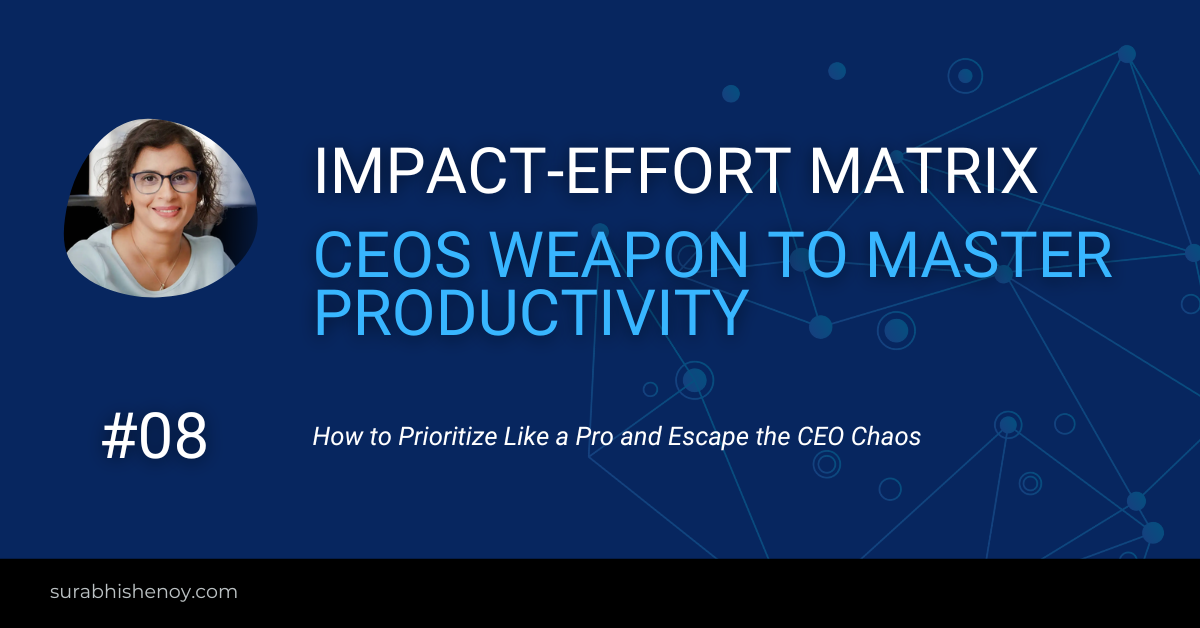As a CEO, you’re no stranger to the relentless barrage of decisions you make each day. The weight of constant decision-making can be overwhelming, from your organization’s strategic direction to the minutiae of daily operations. But what happens when this burden becomes too much to bear? Welcome to the world of decision fatigue.
1. Understanding Decision Fatigue: The CEO's Dilemma
Decision fatigue isn’t just a concept; it’s a reality that many CEOs grapple with daily. It’s the mental exhaustion that sets in after countless choices, big and small, have been made. And as your coach, I recognize the toll it can take on your ability to lead effectively.
But why are CEOs particularly susceptible to decision fatigue? It’s not just the volume of decisions you’re faced with—the weight of responsibility that comes with each. As the ultimate decision-maker, the fate of your organization rests squarely on your shoulders. And that pressure can be overwhelming.
2. The High-Stakes Game: The CEO's Burden
As a CEO, your decisions carry weight for your company and employees’ livelihoods. This added pressure only intensifies the effects of decision fatigue, pushing you further towards the brink.
As a CEO Coach, I am here to help you recognize the signs of decision fatigue early on. Whether opting for simplistic solutions, experiencing physical exhaustion, or noticing a decline in performance quality, these symptoms are your body’s way of telling you it’s time for a change.
3. Strategies for Success: Empowering You to Combat Decision Fatigue
So, how can you combat decision fatigue and reclaim your role as an effective leader?
It starts with delegation. As your coach, I can help you identify which decisions can be delegated to free up your time and mental energy for what truly matters.
But delegation is just the beginning. Prioritizing your mental and physical well-being is equally important. From regular exercise and healthy eating to taking breaks and getting enough sleep, these habits can help keep decision fatigue at bay and ensure you’re operating at your peak performance.
The Power of Coaching: Decision-Making, Data-Driven Leadership, and Organizational Excellence
As a seasoned CEO coach with years of experience guiding executives through their leadership journey, I’ve come to understand the profound impact executive coaching can have on leaders and their organizations. In this in-depth exploration, we shall understand the intricacies of executive coaching, uncovering how it empowers leaders to excel in decision-making, embrace data-driven leadership, and foster a culture of excellence within their teams.
Cultivating Decision-Making Confidence: A Personalized Approach
At the heart of effective leadership lies the ability to make sound decisions confidently. Through personalized coaching sessions tailored to each leader’s unique strengths and challenges, I work closely with executives to build their decision-making confidence from the ground up.
1. Discovering Personal Leadership Styles
One of the first steps in cultivating decision-making confidence is understanding one’s personal leadership style. Through in-depth assessments and one-on-one discussions, executives gain insights into their natural inclinations, communication preferences, and areas for development. By understanding their leadership style, leaders can leverage their strengths and adapt their approach to different situations with confidence.
2. Overcoming Decision-Making Biases
We all have biases that influence our decision-making processes, whether we’re aware of them or not. As a CEO coach, I help executives identify and overcome these biases through targeted exercises and reflective practices. By recognizing cognitive traps such as confirmation bias or anchoring, leaders can make more objective decisions that are grounded in data and evidence.
3. Building Resilience Through Failure
Failure is an inevitable part of leadership, but it’s also an opportunity for growth. Through experiential learning exercises and case studies, executives learn to embrace failure as a learning experience rather than a setback. By reframing failure as a stepping stone to success, leaders build resilience and confidence in their ability to navigate uncertainty and overcome challenges.
Embracing Data-Driven Leadership: Harnessing Insights for Strategic Growth
In today’s rapidly evolving business landscape, data has become the cornerstone of informed decision-making. As a CEO coach, I empower CEO’s to leverage data-driven insights to drive strategic growth and innovation within their organizations.
1. Leveraging Data Analytics Tools
Effective data-driven leadership starts with the right tools and techniques. Through interactive workshops and hands-on training sessions, executives learn to harness the power of data analytics tools such as business intelligence platforms, predictive analytics software, and data visualization tools. By mastering these tools, leaders can extract actionable insights from complex datasets and make informed decisions that drive results.
2. Anticipating Market Trends
In a fast-paced and competitive market, staying ahead of the curve is essential for success. Through data analysis and trend forecasting, executives gain valuable insights into emerging market trends, customer preferences, and industry shifts. By leveraging these insights, leaders can anticipate market changes, identify growth opportunities, and position their organizations for long-term success.
3. Driving Innovation Through Data
Data-driven leadership isn’t just about making better decisions—it’s also about driving innovation and creativity within the organization. By analyzing customer feedback, market research, and performance metrics, executives can identify areas for improvement and innovation. Through collaborative brainstorming sessions and cross-functional initiatives, leaders inspire creativity and drive innovation that fuels growth and competitiveness.
Mastering KPIs and Resource Allocation: Optimizing Performance at Every Level
Key Performance Indicators (KPIs) serve as critical benchmarks for measuring organizational success. In my coaching sessions, I work closely with leaders to develop a deep understanding of KPIs relevant to their industry and business objectives.
1. Setting SMART Goals
Effective KPIs are Specific, Measurable, Achievable, Relevant, and Time-bound (SMART). Through collaborative goal-setting sessions, executives define clear and actionable KPIs that align with strategic priorities and organizational goals. By setting SMART goals, leaders provide clarity and direction to their teams, driving performance and accountability at every level.
2. Allocating Resources Strategically
Resource allocation is a critical aspect of effective leadership. Through data analysis and performance monitoring, executives gain insights into resource utilization and allocation. By optimizing resource allocation based on KPI insights and business objectives, leaders ensure that resources are allocated effectively to maximize performance and drive results.
3. Fostering a Culture of Accountability
Accountability is essential for achieving organizational goals and driving performance excellence. Through regular performance reviews and feedback mechanisms, leaders hold themselves and their teams accountable for results. By fostering a culture of transparency and accountability, leaders create an environment where team members feel empowered to take ownership of their work and strive for excellence.
Enhancing Data Flow for Informed Decision-Making: Creating a Culture of Collaboration
In today’s interconnected world, the seamless flow of data within an organization is paramount to informed decision-making and strategic agility. As a CEO coach, I help leaders implement data-driven processes and protocols that facilitate the exchange of information across departments and teams.
1. Establishing Data Governance Policies
Effective data governance is essential for ensuring data accuracy, integrity, and security. Through one-on-one and collaborative workshops, training sessions, executives develop data governance policies and protocols that govern data collection, storage, and usage. By establishing clear guidelines and standards for data management, leaders create a foundation for informed decision-making and strategic planning.
2. Leveraging Technology for Data Integration
In today’s digital age, technology plays a crucial role in facilitating data integration and collaboration. Through the adoption of integrated data management systems and collaboration tools, executives streamline data flow and communication across departments and teams. By breaking down data silos and enabling real-time access to critical insights, leaders create an agile and responsive organization that can adapt quickly to changing market conditions.
3. Cultivating a Culture of Collaboration and Knowledge Sharing
Collaboration and knowledge sharing are fundamental pillars of a data-driven organization. Through team-building activities and cross-functional initiatives, leaders foster a culture of collaboration where data insights are shared and acted upon in a timely manner. By creating opportunities for open communication and knowledge exchange, leaders empower their teams to make informed decisions and drive organizational success.
CEO and Executive coaching represents a transformative journey for leaders seeking to unlock their full potential and drive organizational success. By building decision-making confidence, embracing data-driven insights, and fostering a culture of collaboration, executives can navigate complexity with clarity and lead their organizations to new heights of achievement.
As a CEO coach committed to delivering results, I stand ready to guide leaders on their journey to excellence, equipping them with the tools and strategies they need to succeed in today’s competitive business landscape.
In Conclusion
Decision fatigue may be formidable, but you can overcome it with a robust support system. By recognizing the signs, delegating responsibilities, prioritizing self-care, and seeking professional coaching, you can reclaim your clarity, confidence, and effectiveness as a CEO.
So, are you ready to take back control? Get in touch with us today!







